Pathways: A new approach for women in entrepreneurship
An independent review into women in entrepreneurship in Scotland, authored by Ana Stewart and Mark Logan. Based on thorough data analysis and stakeholder engagement the report's recommendations seek to address the root causes of female under-participation in entrepreneurship.
02. Approach and rationale
Before commencing our analysis into imbalances in entrepreneurship participation, we'll first explain the approach that we have adopted to conduct that analysis. We explore why these imbalances have persisted over many years, despite multiple prior attempts to address them. From this discussion, we highlight four pitfalls that help to illuminate the reasons why such prior efforts have not had the intended scale of impact. Finally, we define an approach intended to avoid these pitfalls and, therefore, to result in more impactful recommendations.
Severe imbalances in gender representation have persisted over the long term across many domains, and not least in the field of entrepreneurial activity. The chart below illustrates the recent and current situation. During the worst of the Covid-19 crisis, this gender gap even increased slightly[31].
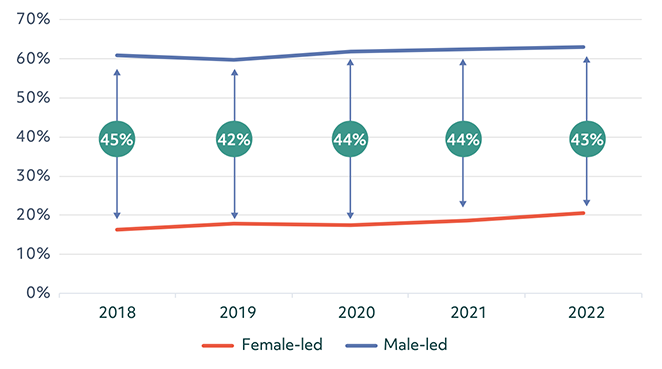
Source mnAI Data Analysis for Scotland's Incorporations, 2022
These imbalances exist despite numerous endeavours intended to address them. Such progress that is made remains incremental in nature, while the general imbalances still persist at scale and to largely the same degree of severity as before.
"Whilst there might be modest growth in the numbers of women led firms being incorporated in recent years this, I do not think, will translate into transformational change as the structural and system-wide inhibitors that continue to exist in the labour market are absolutely mirrored, and possibly amplified in the field of entrepreneurship." - Professor Eleanor Shaw, Strathclyde University
To make interventions that sufficiently improve gender representation in entrepreneurship and related fields, we must first understand why we haven't made meaningful progress to date, despite those prior efforts. We can then adapt our approach as a result of that understanding. Otherwise, the same approach will yield the same, underwhelming results.
Below, we have identified four pitfalls often present in approaches intended to improve participation rates. These typically act together to inadvertently compromise the ambition of recommended actions:
- Normalisation of extremes and the influence of anchoring effects
- Focussing only on proximate causes instead of root causes
- Adding to broken systems instead of fixing them
- Favouring tokenism over scaled solutions
We next discuss each of these pitfalls in turn. From that discussion, we'll distil a set of guiding principles and a recommendations framework to assist us in avoiding them.
Normalisation of extremes and the influence of anchoring effects
Through ongoing societal conditioning and reinforcement mechanisms, there exists a strong tendency to normalise participation imbalances and to become psychologically anchored by them when discussing improvements.
A consequence of this tendency is to reduce the boldness and ambition of endeavours aimed at improving under-participation within a given demographic. After all, if society considers a particular state of affairs to be "normal", it is unlikely to invest the energy, money and time required to significantly alter that normal. Instead, relatively minor measures are prescribed, which pass the twin tests of being uncontroversial and easy to implement.
But such an approach acts only to strengthen the existing normalisation process. Because such measures result in only limited or no change to the target imbalances, they reinforce the mistaken belief that the status-quo is the natural way of things (otherwise, the argument goes, participation rates would have adjusted in response to those interventions).
Thus, a reinforcing loop comes into effect, which serves to harden existing attitudes against change:
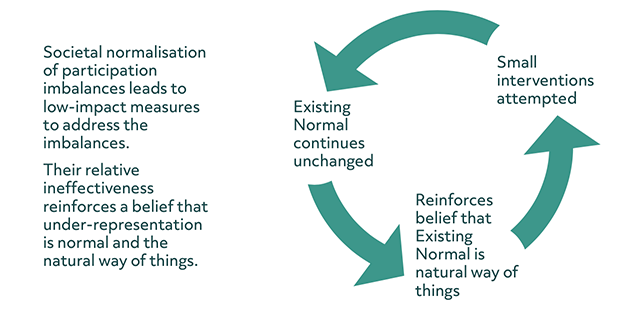
We must consciously break out of this reinforcing loop when designing interventions, and the will to do so may lead to very different solutions than would otherwise have emerged. By analogy, consider the different responses needed to meet a goal of achieving either a 10% improvement or a 10X improvement in some system. A completely different approach is required in each case.
This is the philosophy that we attempt to adopt in this report. At policy level, our goal is to make participation rates 10X better, not 10% better. The starting point for achieving that goal is to reset our anchoring point. Instead of asking how we can raise participation rates from the current level by some degree, we instead ask: what prevents equal per-capita participation levels?
Focussing only on Proximate Causes instead of Root Causes
Under-participation of women in entrepreneurship and other fields is not only a problem in itself, but also a symptom of other, deeper problems. These deeper problems must also be exposed and addressed if we are to meaningfully rebalance participation rates.
When considering under-participation in a given field, it is common to focus largely on finding solutions to the proximate causes of the problem. But this is only effective if we also act upon the problem's deeper, underlying causes.
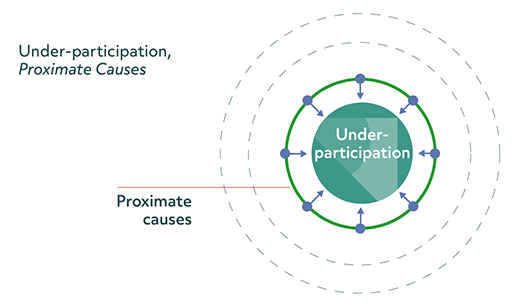
Proximate causes are those that most immediately and directly lead to a visible manifestation of under-participation. Focussing exclusively on proximate causes naturally tends to result in solutions being identified and directly applied to those proximate causes. But the deeper, background causes remain. Left unaddressed, these deeper causes will continuously act to reinstate the proximate causes and, hence, their consequential symptoms (extreme under-participation rates).
For example, one of the proximate causes of women under-participating in certain kinds of entrepreneurship is that female founders receive considerably less funding per-capita than men. One solution to that proximate cause is therefore to create a special fund that invests only in women founders. While such an intervention is useful as a mitigation, it is not in itself a sufficient solution; on its own, it is neither scalable (i.e., it won't fully mitigate the wider industry's under-investment in women) nor sustainable over the long term (i.e., the deeper causes will persist at scale and will regularly act to re-assert the proximate cause, for example, once the funding for this solution is eventually wound down).
Mitigating proximate causes, as in the example above, is certainly one of the tools available to us. But, if we are to make scaled and permanent progress on any given type of symptomatic under-participation, we must also go deeper, recognizing that proximate causes themselves have causes. In this report, we refer to these as intermediate causes:
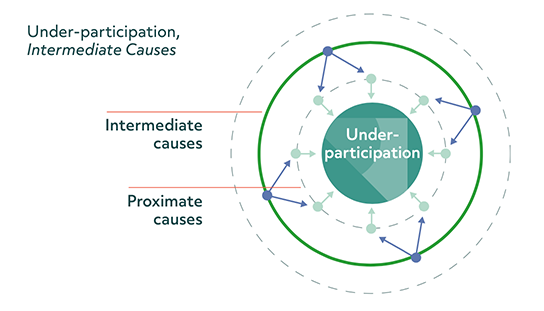
Such intermediate causes will work to undermine solutions that we apply directly to the proximate causes discussed above. And they will constrain those solutions from spontaneously scaling. It's clear that we must therefore also address these intermediate causes, if we are to permanently address the proximate causes and, ultimately, under-participation itself.
We can do this in two ways. As before, we can mitigate the intermediate causes with solutions designed to directly address them, and we can move one step further and acknowledge that, often, many intermediate causes themselves exist as result of a set of root causes:
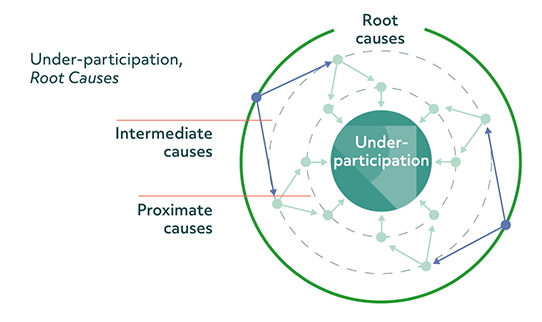
In the context of our report, these root causes are often expressed in terms of the societal beliefs, norms, attitudes and prejudices that continuously re-instate the intermediate causes. These, in turn, then act to constrain and undermine the solutions being applied directly to proximate causes.
To bring about lasting and significant change, it is critically important that, whatever else we do, we must also address these root causes, even as we mitigate their consequential effects described above.
The above analysis helps to illuminate why most initiatives don't bring about lasting and significant change to the problem of under-participation. Their remits often focus on solutions to largely proximate causes. This is understandable - proximate causes are both more identifiable and generally more convenient to address than their underlying causes. And they may temporarily return visible results more quickly, albeit in only limited ways, which can be politically attractive.
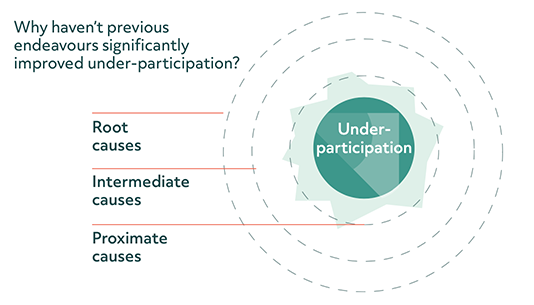
But focussing only on the proximate causes of under-participation contributes to the normalisation and anchoring issues discussed earlier and has a worse than neutral effect on the issue. Proximate solutions tend to be limited in both scale and scope and are undermined by deeper causal effects. Their consequent relative ineffectiveness contributes to the normalisation of under-participation described earlier.
Of course, everyone likes quick results, which makes solutions to proximate causes attractive. But most people also like lasting, impactful and scaled outcomes. That is why this report takes a portfolio-based approach, that aims to cover all radii of the problem space, combining near-term mitigations with longer-term measures that address the root causes of under-participation.
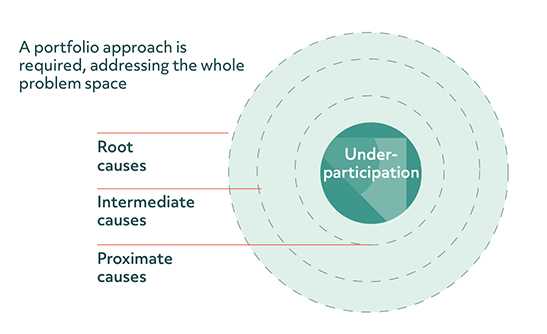
Proximate Solutions tend to deliver results quickly (high responsiveness) but with limited long-term impact (low permanence and scale). And, because they don't challenge core societal or industry norms and behaviours, they tend not to cause controversy (low outrage), hence are easier to implement.
Solutions to Root Cause issues have the opposite characteristics. They don't yield immediate results (low responsiveness), but their impact is much greater (high permanence and scale). Implementing them requires much wider societal or industry change, in terms of attitudes and behaviours (high outrage) making them harder to implement.
To balance early progress with permanent change in outcomes, a portfolio approach is therefore essential.
This is also why some of our recommendations initially seem to be placed far from our target in temporal terms whereas, in reality, they lie in close causal proximity. A further consequence of this connectedness is that recommendations in this report cannot easily be "cherry-picked" for expediency without significantly reducing their overall effectiveness.
Adding to broken systems instead of fixing them
A broken machine will continue to produce the wrong outputs as long as it remains broken. Faced with such a situation, we have a choice: we can attempt to manage, with special measures, the various individual issues arising from that malfunction, or we can fix the machine.
Consider, for example, the engine in a family car. We could address an oil leak by suspending a bucket from beneath the car's chassis, under the site of the leak. Or we could manage a sudden unpleasant grinding sound by installing noise cancellation. Obviously, these solutions wouldn't succeed for very long. It's much better to fix the engine.
The entrepreneurial ecosystem is broken too. This is apparent in its chronic failure to enable female entrepreneurs to thrive in the same way as it supports others to do so. As with our broken engine analogy, the ecosystem signals its breakdown in various ways; for example, in chronic, acute underfunding female founders, in under-participation in STEM subjects, in the lack of representation at leadership and CEO levels in companies, to name but three.
We don't successfully fix such a system by "hanging a bucket under the chassis". Nor, for that matter, by attempting to constrain those for whom the system currently works well. Rather, we fix it by engineering an ecosystem that works well for all demographics, for everyone.
For example, if women founders feel under-supported or unwelcome in a start-up incubator should we start a special incubator for women or should we instead make incubators in general work for everyone? The former is an example of adding on top of a broken system. The latter approach is certainly more difficult but ultimately more powerful. It has inherent scale, and is more cost-effective. It is also far more likely that this approach, if properly implemented, will benefit all under-participating demographics rather than just one.
This choice is an example of the Proximate/Intermediate/Root Cause model from our preceding section. We give it particular attention in this report, because the practice of adding to a broken system in this way is widespread.
Favouring tokenism over scaled solutions
Under-participation is a universal issue, which makes it a highly scaled problem[32]. Highly scaled problems require correspondingly scaled solutions. But, without widespread societal agreement and a corresponding sense of urgency, such change is inertial at best.
Recognition of this inertia often results in token, point solutions that are relatively easy to implement but that don't match the scale of the problem. They are likely well-intentioned, seeking to act as "pathfinders" for what could be achieved in future. But, at other times, they may only serve political expediency ("something must be done, this is something"). They are frequently counterproductive to our goals because their existence causes concern over the original issue to be stood down.
Note that this pitfall is different to the case where a solution is trialled in one or two areas before being scaled. But here we must be careful. Often, token solutions that start out as trials of future scaled rollouts never move beyond the trial stage, even when trial results indicate that they should. Agendas change, people forget.
Consequently, recommended interventions need to include the process of developing a wide-spread societal intolerance of the current extremely imbalanced participation rates in entrepreneurialism. Only by doing so can we enlist the scaled support needed to fully develop, implement and sustain scaled solutions.
From the foregoing discussion, we can derive a set of principles to guide the recommendations made in this report and an associated recommendations framework within which those principles can be applied.
Key Principles of our Approach
We will use the following principles when setting recommendations to counter the pitfalls discussed above:
Principle 1: The existing anchoring point for defining tolerable participation rates should be consciously disregarded. We must anchor our definition of "good enough" in the territory of equal gender participation rates.
Principle 2: A balanced portfolio of interventions is required, blending near-term benefits with longer-term initiatives that bring about a permanent change in attitudes. This portfolio should reflect the cause-and-effect relationships between issues acting to limit equal participation rates.
Principle 3: Recommendations should be biased towards making the ecosystem inherently work for everyone, rather than mitigating its inequalities through point solutions built on top of broken systems.
Principle 4: Practical scalability must be designed-in to interventions and societal/industry participation must a priori be addressed as part of delivering that scale.
Recommendations Framework
The foregoing analysis suggests a framework to support the development of recommendations. Firstly, we identify a set of proximate causes of under-participation. These will serve as our focal areas for the remainder of the report:
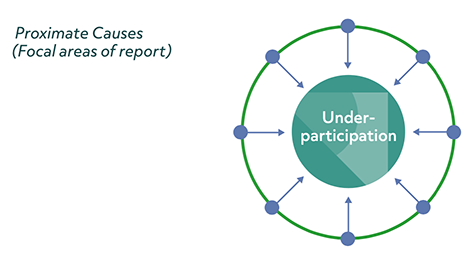
For each of these focal areas, we can then derive its corresponding cause-and-effect tree. This will reveal a set of intermediate and root causes of the issue.
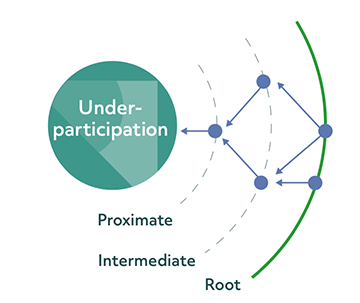
In the next chapter of this report, we identify these proximate causes of under-participation. These are the key focal areas of the rest of the report. In subsequent chapters, each focal area is then developed according to this framework. General beneficial interventions are identified, guided by our four principles identified earlier. In Chapter 10, these general intervention options are distilled and integrated into specific, concrete recommendations.
Contact
Email: EIDEEBSPEnquires@gov.scot
There is a problem
Thanks for your feedback